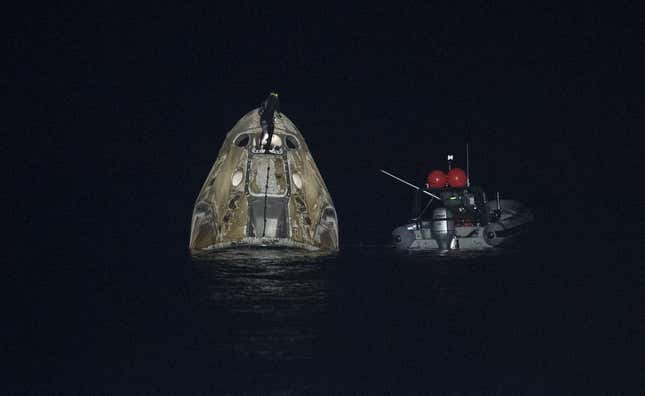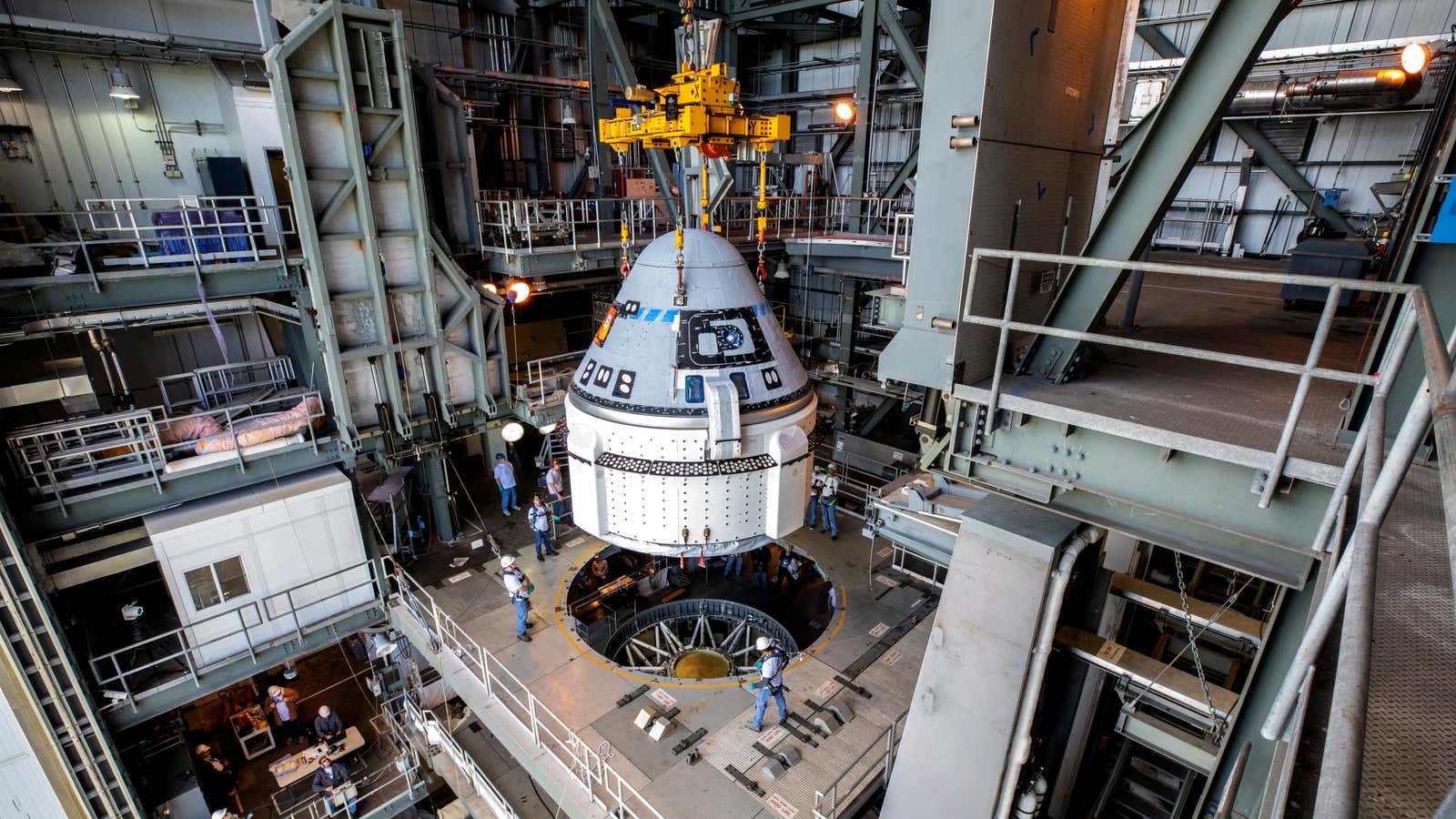Dear readers,
Welcome to Quartz’s newsletter on the economic possibilities of the extraterrestrial sphere. Please forward widely, and let me know what you think. This week: Starliner is Boeing’s big test, Artemis dates, and nuclear power in space.
🚀 🚀 🚀
Boeing’s Starliner space capsule is expected to make its third attempt to reach the International Space Station today, in a demonstration ahead of a crewed test flight with two astronauts onboard.
The spacecraft, built with NASA’s support as part of the commercial crew program, has a history of error. Its first test flight in 2019 failed to reach the orbital laboratory due to software screw-ups and a lack of testing. A second attempt in 2021 led engineers to discover faulty valves, which required months of investigation to correct. The delay and extra work has cost the company at least $585 million.
The Starliner saga is emblematic of the aerospace giant’s recent troubles, just like the 737 Max and the KC-46 tanker. Three straight years of losses—the pandemic didn’t help sell aircraft, either—contributed to its stock falling 70% since peaking in early 2019. The company’s reputation as a center for engineering and program management excellence has taken a real step back.
If all goes as planned today, it would be a boost for the company. But it won’t be the end of the challenges on this project. A group of independent NASA safety advisers warned last week that Boeing is still working through parachute issues and should take its time getting to the crewed flight test. They also fretted that Boeing is running the program with bare-bones staffing, and is still debating redesigning those sticky valves sometime before the first crewed flight.
Depending on how much profit margin it built into its bids, it seems likely that Boeing is losing money on Starliner. That might not change soon. SpaceX is selling trips on its Dragon to private citizens and companies, but Starliner will have a hard time doing the same: It is designed to fly on ULA’s Atlas V rocket, and eight have been reserved for the job—two for the remaining test flights, and six to ferry astronauts to the International Space Station during normal service.
There are no more Atlas V rockets left to assign to new missions. To fly paying customers (or if something goes wrong in the final test flights), ULA would need to upgrade its new rocket, Vulcan, to safely carry passengers, or Boeing would need to figure out how to launch Starliner on a competitor’s rocket.
All that is a lot of risk for Boeing—indeed, risk that NASA intentionally shifted to the company as part of the procurement process. The commercial crew program is a fixed-price contract that incentivizes companies to be as efficient as possible. But while it’s good to see someone other than taxpayers on the hook for mismanagement and mistakes, Boeing’s struggles are both a justification for, and a threat to, the future of this model.
When Boeing bid to build Starliner, it was a big moment for the fixed-price, public-private partnership model of building space hardware: A traditional NASA powerhouse (and its army of lobbyists) joining the upstarts. Few expected that Boeing would face the difficulties that it has. Lori Garver, a top NASA official when these programs were designed, said last week that, in her view, Boeing would not take on the challenge with the benefit of hindsight.
Let’s hope that Boeing executives think they can do a better job on their next fixed-price assignment, or at least feel NASA’s generous payments for building the Space Launch System make up some of the Starliner loss. The US space agency (and its space industry) need a competitor for SpaceX, and thus far none of the obvious contenders have stepped up to the plate. Boeing has the capital and the experience, but today it needs to prove it can execute.
Watch Starliner’s flight test, expected to launch at 6:54pm ET from Cape Canaveral, on NASA TV.
🌘 🌘 🌘
Imagery interlude
The other product of NASA’s commercial crew program, the SpaceX Crew Dragon, being recovered from the Gulf of Mexico on May 6 after returning four astronauts from the ISS. As you can see from the scorched exterior, the thermal protection system gets a good work out on its trip back to Earth.

🎧🎧🎧
Deconstructing dyslexia. Since dyslexia was first identified in the 1870s, psychologists, teachers, politicians, and parents have questioned its definition, its causes, and even its very existence. As a result, dyslexia is today known by enduring myths, which science is finally starting to debunk. Learn more with this week’s episode of the Quartz Obsession podcast.
Listen on: Apple Podcasts | Spotify | Google | Stitcher
🛰🛰🛰
SPACE DEBRIS
High hopes for Artemis-1. The final tests of NASA’s Moon rocket, the Space Launch System, has been delayed to June, but the agency still hopes that it will head for deep space in August. In case of more delay, NASA planners are considering dates in the first half of 2023 for this mission, which was originally expected in 2016.
Uzbekistan asks for space internet. The government of Uzbekistan is the latest to begin working with SpaceX’s Starlink and OneWeb to bring satellite connectivity to its country. Market access is one of the toughest challenges for companies deploying massive satellite networks in low-Earth orbit, which need customers around the globe to avoid wasting capacity.
DOD backs nuclear space start-ups. A pair of start-ups have received funding from the Defense Innovation Unit to advance the use of nuclear power in space. One company, Ultra Safe Nuclear Technologies, is building a more powerful nuclear battery for space vehicles, while another, Avalanche Energy, wants to use fusion technology for spacecraft propulsion.
Farming the Moon. Scientists have grown plants in samples of lunar soil brought back by Apollo astronauts. While blossoming lunar greenhouses are still a ways off, the experiment could pave the way for agricultural production on the Moon—and shed light on techniques for growing plants in harsh soils here on Earth.
Chain gang. Satellite builders are still suffering from lagging supply chains for key components like chipsets and radios, and the US Space Development Agency’s contractors are swapping parts from their inventories just to get their satellites into space on time.
Ad Alameda. The cash sloshing into space SPACs has yet to produce a winning business, but besides the potential of far-reaching innovation beyond our planet, some of that money is having a concrete terrestrial impact: Astra Space, for example, is helping redevelop a shuttered Navy base on the San Francisco Bay.
your pal,
Tim
This was issue 133 of our newsletter. Hope your week is out of this world! Please send internal financial documents for Starliner, engine pressure data on the BE-4 engine, tips, and informed opinions to [email protected].
